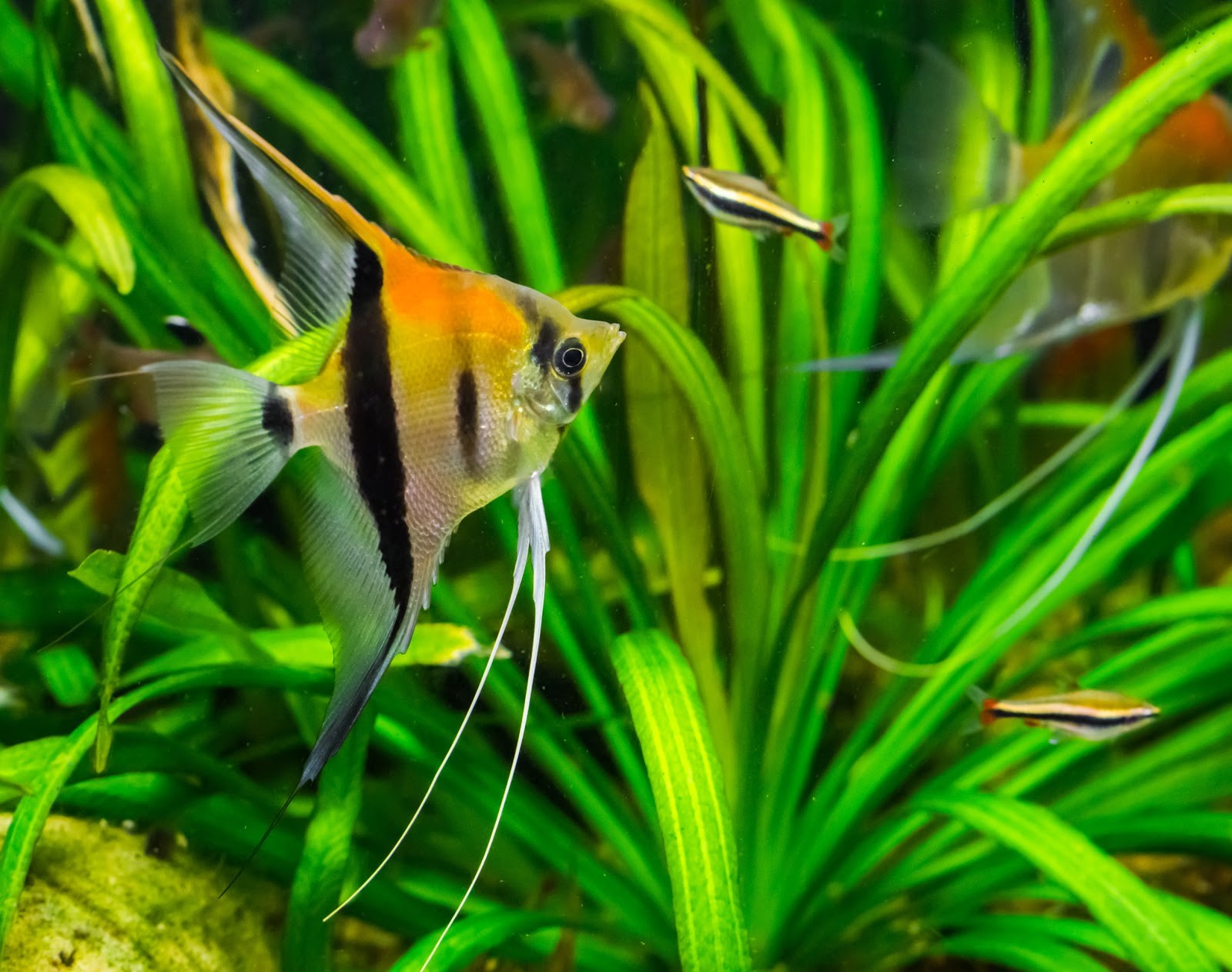As we’ve mentioned in the angelfish care guide, we adore the sight of an amazing angelfish aquarium filled with members of this regal species. But what if you want to add some other fish as well? Angels are skittish and need calm, but at the same time they’re able to easily eat smaller tankmates.
Luckily, there are still options! Keep reading to find out 6 of our favorite tankmates for angelfish.
Black Skirt Tetra (Gymnocorymbus Ternetzi)
Many tetra species make a good match for angelfish, but the problem is that some of the more obvious choices, like the neon tetra, fit just a little too easily into the angels’ mouths. A great way to avoid this issue is to go for a variety that’s a bit harder for them to eat. A good example of that is the black skirt tetra.
Black skirts are peaceful and won’t bother your angelfish. A large group of them makes for an amazing sight, and as an added bonus, they’re also available in a fascinating albino version. Additionally, GloFish created genetically modified glowing black skirt tetras in bright pink, blue, green and more.
Marbled hatchetfish (Carnegiella strigata)
A good way to make sure your angelfish won’t bother their tankmates is to go for a species that resides in a different water layer. The exclusively top-dwelling hatchetfish is a great example of this. The hatchetfish are too large to be eaten and won’t hang around your angels much, so the two species will leave each other alone.
The most common hatchetfish variety you’ll find in your local aquarium store is the marbled hatchetfish, Carnegiella strigata. This strange-looking, almost triangular species has the “looking like a dead leaf” camouflage strategy down perfectly.
Tip: What has to be said about all hatchetfish is that they’re prone to jumping when scared. Keep in mind that a lidless aquarium is out of the question if you’d like to keep this species!
Bristlenose Pleco (Ancistrus sp.)
Another good example of a fish that inhabits a different water layer than your angelfish is the bottom-dwelling bristlenose Pleco from the Ancistrus genus. This catfish tends to sit on rocks or driftwood and mainly comes out at night. It’s so well-camouflaged the angels probably won’t even realize it’s there!
The bristlenose Pleco is not the only Plecostomus species that would work in your angelfish aquarium. As long as you meet their care guidelines, there are more, like the clown Pleco, L333 Pleco and snowball Pleco. Avoid XL species like sailfin and common Plecos, as those tend to grow too large for the average home aquarium and may end up bothering your angels.
All of the small species will be happy in your angelfish aquarium as long as they’re provided with plenty of caves and hides. In lucky cases, they might even produce some offspring.
Pencilfish (Nannostomus sp.)
Another schooling fish that mainly inhabits the top water layer and gets a bit too large for your angelfish to eat would be pencilfish from the Nannostomus genus. Perfect for those bored with tetras and looking for something a bit more original!
The most common variety you’ll find in the aquarium hobby is probably Nannostomus beckfordi, the Beckford’s pencilfish. We also really like the colorful Nannostomus mortenthaleri, the coral red pencilfish.
When buying pencilfish (and any schooling fish) for your angelfish aquarium, be sure to choose adult specimens. Many aquarium fish are sold as juveniles and baby pencilfish will definitely still be small enough to get eaten by adult angelfish. If you can’t find adult fish, it might be worth growing them out in a separate aquarium before adding them to your angelfish tank!
Corydoras Catfish (Corydoras sp.)
Corydoras catfish like the Corydoras aeneus are pretty much the ideal community fish for any aquarium. Angelfish tanks are no exception. They’re bottom dwellers so they don’t get into the way of other species, and most are large enough to avoid being eaten. Just avoid the tiny dwarf species and you’re golden.
Additionally, although they’re 100% peaceful, Corydoras’ hardened body plates make them sturdy. They can even raise a sharp spine if any curious angel gets too close. The common name for the genus is ‘armored catfish’, after all!
If you want to keep Corydoras catfish in your angelfish aquarium, just make sure you’re using a sandy substrate. They’ll greatly appreciate being able to forage on the bottom of the tank without damaging their delicate barbels.
Bolivian Ram (Mikrogeophagus altispinosus)
Angelfish can be combined with many types of dwarf cichlids from the Apistogramma genus. Another popular choice are German blue rams (Mikrogeophagus ramirezi). Not surprising, as these colorful fish are nice to look at and generally don’t cause too much trouble.
However, because the German ram has become the victim of excessive selective breeding and many specimens can be quite weak at this point, our secret is to go for its cousin instead. The Bolivian ram (Mikrogeophagus altispinosus) is a lot sturdier and will last you much longer in most cases.
Although Bolivian rams are mostly peaceful, they are still assertive, especially if they’re courting and breeding. You can keep a pair in your angelfish aquarium, but if you really don’t like seeing fish squabble, you might be better off skipping them.
Bad Tankmates for Angelfish
Yep, not every species works well with angelfish. Sometimes it’s the angelfish that don’t play nice with their tankmates. Other times, their neighbors are just too boisterous or aggressive, stressing out these divas of the Amazon.
Here are some popular aquarium fish you should avoid combining with angels:
- Guppies: their long fins make them much too prone to becoming victims of fin nipping
- Betta fish: same problem, plus they need peace and quiet to thrive
- Tiger barbs: known for being nippy, they’re likely to bother your angelfish
- Goldfish: require completely different water temperatures and composition
- Rift Lake cichlids (Malawi/Tanganyika): need different water values and can be aggressive
- Silver dollars: too hyperactive for the tranquil angelfish
It goes without saying that you should also avoid “monster fish” like oscar cichlids, piranhas, arowanas, snakeheads, and the like.
Conclusion
An angelfish aquarium is an amazing addition to any home and even more so if you choose the right tankmates to accompany these cichlids. If you’re concerned about the task of working on a large tank like this or if you just want to skip all the hassle, FantaSEA Aquariums can set up the perfect angelfish habitat in your home or office. Just contact us here with your ideas!











I have black skirt tetras (fully grown) and fully grown angel fish, and the black skirt tetras try to nip my angel fish fins, they killed all of the babies so I tried again with adults, so that would be false info. I had to put them in a different tank.
Hey! Sorry to hear this didn’t work out for you. How large are the groups and how big is the tank? I’d recommend at least 6 angels and at least 10 black skirts in order for them to feel secure, in an aquarium of ideally around 100 gallons. Otherwise things can get cramped and stressy, especially considering how large adult angels get. I’ll change the wording in the post. Good luck!